SUBARU OUTBACK 2005 4.G Owners Manual
Manufacturer: SUBARU, Model Year: 2005, Model line: OUTBACK, Model: SUBARU OUTBACK 2005 4.GPages: 627, PDF Size: 6.42 MB
Page 391 of 627
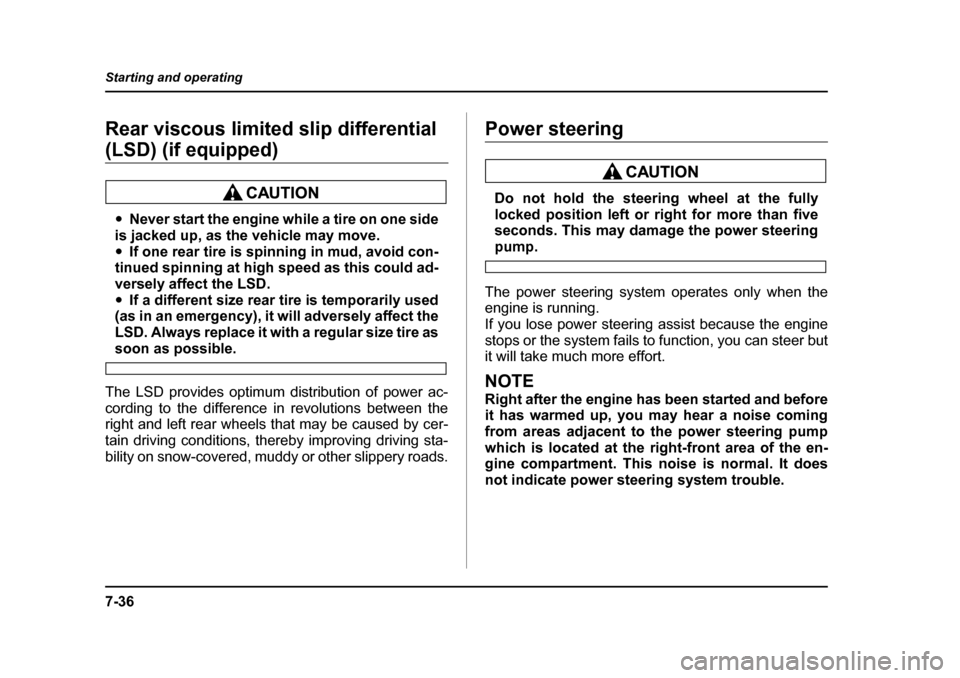
7-36
Starting and operating
Rear viscous limited slip differential
(LSD) (if equipped)
"
Never start the engine while a tire on one side
is jacked up, as the vehicle may move. " If one rear tire is spinning in mud, avoid con-
tinued spinning at high speed as this could ad-
versely affect the LSD. " If a different size rear tire is temporarily used
(as in an emergency), it will adversely affect the
LSD. Always replace it with a regular size tire as
soon as possible.
The LSD provides optimum distribution of power ac-
cording to the difference in revolutions between the
right and left rear wheels that may be caused by cer-
tain driving conditions, thereby improving driving sta-
bility on snow-covered, muddy or other slippery roads.
Power steering
Do not hold the steering wheel at the fully
locked position left or right for more than five
seconds. This may damage the power steering
pump.
The power steering system operates only when the
engine is running.
If you lose power steering assist because the engine
stops or the system fails to function, you can steer but
it will take much more effort.
NOTE
Right after the engine has been started and before
it has warmed up, you may hear a noise coming
from areas adjacent to the power steering pump
which is located at the right-front area of the en-
gine compartment. This noise is normal. It does
not indicate power steering system trouble.
Page 392 of 627
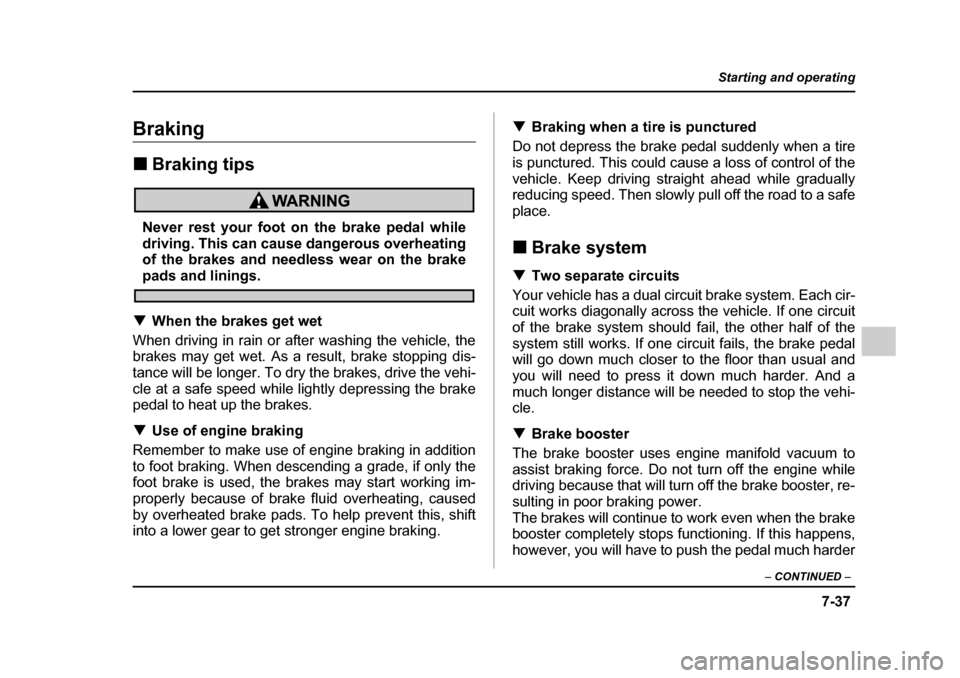
7-37
Starting and operating
– CONTINUED –
Braking !Braking tips
Never rest your foot on the brake pedal while
driving. This can cause dangerous overheating
of the brakes and needless wear on the brake
pads and linings.
! When the brakes get wet
When driving in rain or after washing the vehicle, the
brakes may get wet. As a result, brake stopping dis-
tance will be longer. To dry the brakes, drive the vehi-
cle at a safe speed while lightly depressing the brake
pedal to heat up the brakes. ! Use of engine braking
Remember to make use of engine braking in addition
to foot braking. When descending a grade, if only the
foot brake is used, the brakes may start working im-
properly because of brake fluid overheating, caused
by overheated brake pads. To help prevent this, shift
into a lower gear to get stronger engine braking. !
Braking when a tire is punctured
Do not depress the brake pedal suddenly when a tire
is punctured. This could cause a loss of control of the
vehicle. Keep driving straight ahead while gradually
reducing speed. Then slowly pull off the road to a safe
place. ! Brake system
! Two separate circuits
Your vehicle has a dual circuit brake system. Each cir-
cuit works diagonally across the vehicle. If one circuit
of the brake system should fail, the other half of the
system still works. If one circuit fails, the brake pedal
will go down much closer to the floor than usual and
you will need to press it down much harder. And a
much longer distance will be needed to stop the vehi- cle. ! Brake booster
The brake booster uses engine manifold vacuum to
assist braking force. Do not turn off the engine while
driving because that will turn off the brake booster, re-
sulting in poor braking power.
The brakes will continue to work even when the brake
booster completely stops functioning. If this happens,
however, you will have to push the pedal much harder
Page 393 of 627
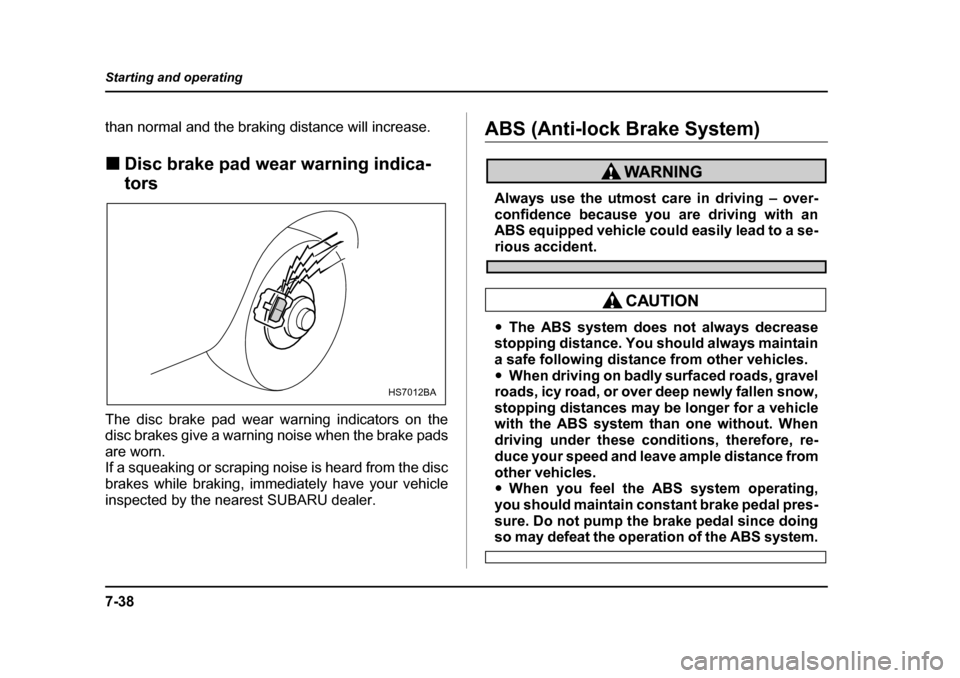
7-38
Starting and operating
than normal and the braking distance will increase. !
Disc brake pad wear warning indica- tors
The disc brake pad wear warning indicators on the
disc brakes give a warning noise when the brake pads
are worn.
If a squeaking or scraping noise is heard from the disc
brakes while braking, immediately have your vehicle
inspected by the nearest SUBARU dealer.ABS (Anti-lock Brake System)
Always use the utmost care in driving – over-
confidence because you are driving with an
ABS equipped vehicle could easily lead to a se-
rious accident.
" The ABS system does not always decrease
stopping distance. You should always maintain
a safe following distance from other vehicles. " When driving on badly surfaced roads, gravel
roads, icy road, or over deep newly fallen snow,
stopping distances may be longer for a vehicle
with the ABS system than one without. When
driving under these conditions, therefore, re-
duce your speed and leave ample distance from
other vehicles. " When you feel the ABS system operating,
you should maintain constant brake pedal pres-
sure. Do not pump the brake pedal since doing
so may defeat the operation of the ABS system.
HS7012BA
Page 394 of 627
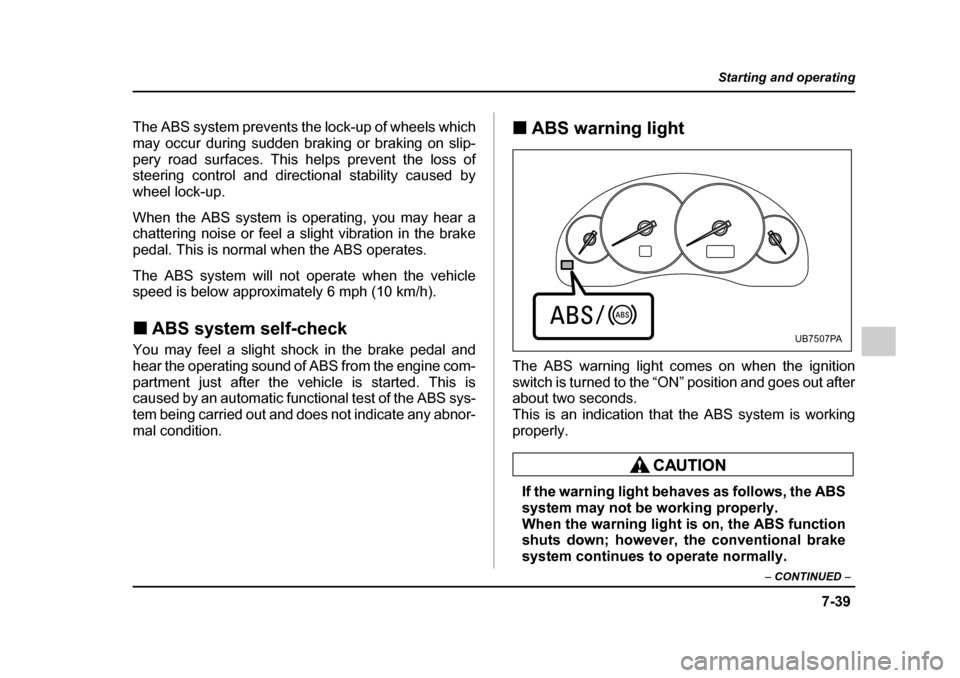
7-39
Starting and operating
– CONTINUED –
The ABS system prevents the lock-up of wheels which
may occur during sudden braking or braking on slip-
pery road surfaces. This helps prevent the loss of
steering control and directional stability caused by
wheel lock-up.
When the ABS system is operating, you may hear a
chattering noise or feel a slight vibration in the brake
pedal. This is normal when the ABS operates.
The ABS system will not operate when the vehicle
speed is below approximately 6 mph (10 km/h). !ABS system self-check
You may feel a slight shock in the brake pedal and hear the operating sound of ABS from the engine com-
partment just after the vehicle is started. This is
caused by an automatic functional test of the ABS sys-
tem being carried out and does not indicate any abnor-
mal condition. !
ABS warning light
The ABS warning light comes on when the ignition
switch is turned to the “ON” position and goes out after
about two seconds.
This is an indication that the ABS system is working
properly.
If the warning light behaves as follows, the ABS
system may not be working properly.
When the warning light is on, the ABS function
shuts down; however, the conventional brake
system continues to operate normally.
UB7507PA
Page 395 of 627
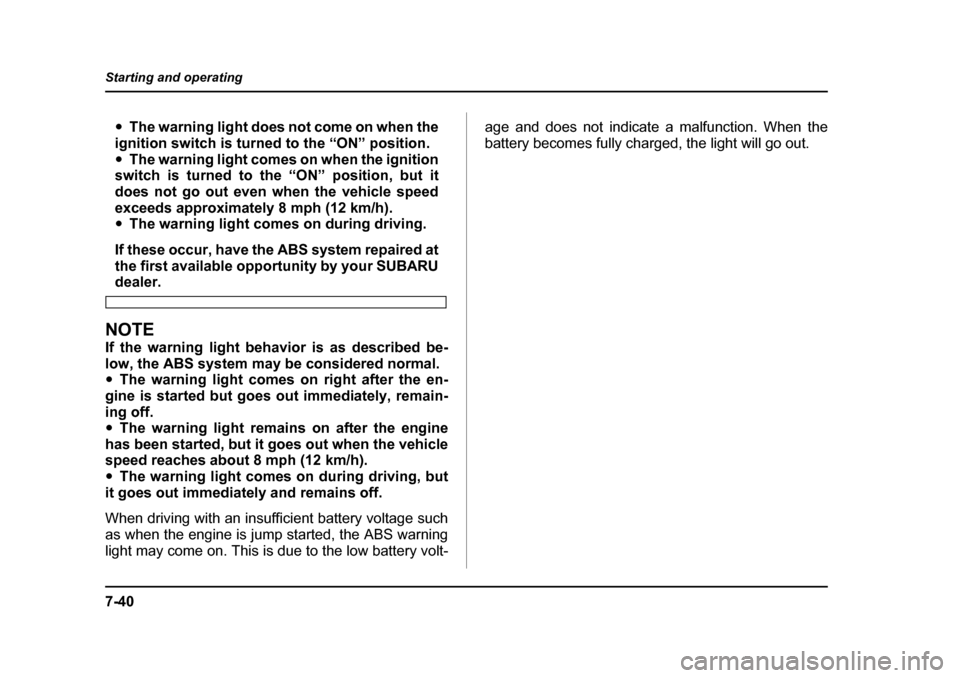
7-40
Starting and operating
"
The warning light does not come on when the
ignition switch is turned to the “ON” position. " The warning light comes on when the ignition
switch is turned to the “ON” position, but it
does not go out even when the vehicle speed
exceeds approximately 8 mph (12 km/h). " The warning light comes on during driving.
If these occur, have the ABS system repaired at
the first available opportunity by your SUBARU
dealer.
NOTE
If the warning light behavior is as described be-
low, the ABS system may be considered normal. " The warning light comes on right after the en-
gine is started but goes out immediately, remain-
ing off. " The warning light remains on after the engine
has been started, but it goes out when the vehicle
speed reaches about 8 mph (12 km/h). " The warning light comes on during driving, but
it goes out immediately and remains off.
When driving with an insufficient battery voltage such
as when the engine is jump started, the ABS warning
light may come on. This is due to the low battery volt- age and does not indicate a malfunction. When the
battery becomes fully charged, the light will go out.
Page 396 of 627
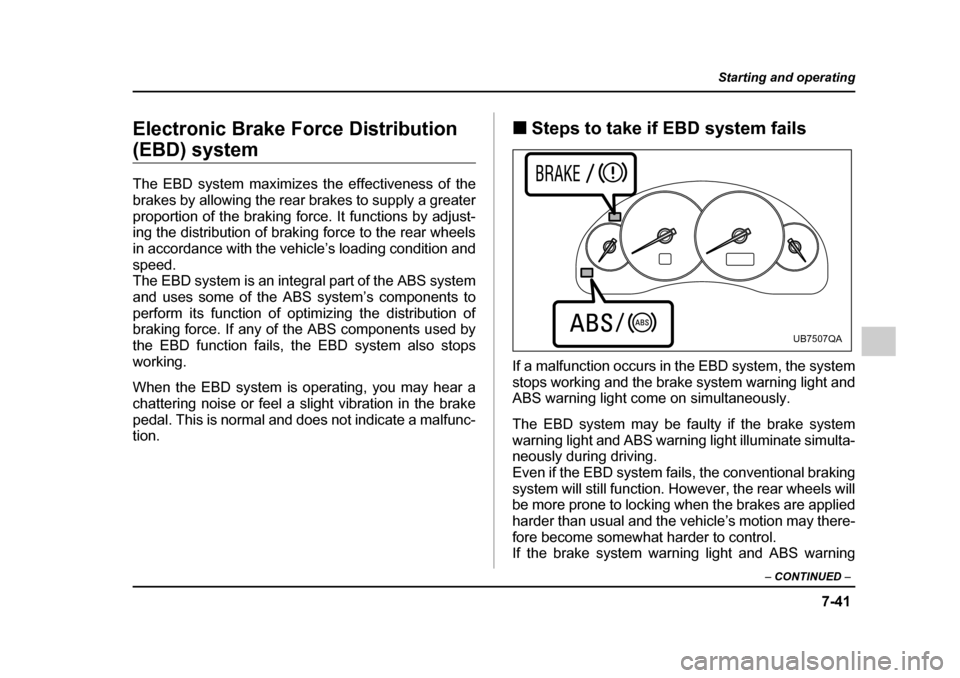
7-41
Starting and operating
– CONTINUED –
Electronic Brake Force Distribution
(EBD) system
The EBD system maximizes the effectiveness of the
brakes by allowing the rear brakes to supply a greater
proportion of the braking force. It functions by adjust-
ing the distribution of braking force to the rear wheels
in accordance with the vehicle’s loading condition and
speed.
The EBD system is an integral part of the ABS system
and uses some of the ABS system’s components to
perform its function of optimizing the distribution of
braking force. If any of the ABS components used by
the EBD function fails, the EBD system also stops
working.
When the EBD system is operating, you may hear a
chattering noise or feel a slight vibration in the brake
pedal. This is normal and does not indicate a malfunc- tion. !
Steps to take if EBD system fails
If a malfunction occurs in the EBD system, the system
stops working and the brake system warning light and
ABS warning light come on simultaneously.
The EBD system may be faulty if the brake system
warning light and ABS warning light illuminate simulta-
neously during driving.
Even if the EBD system fails, the conventional braking
system will still function. However, the rear wheels will
be more prone to locking when the brakes are applied
harder than usual and the vehicle’s motion may there-
fore become somewhat harder to control.
If the brake system warning light and ABS warning
UB7507QA
Page 397 of 627
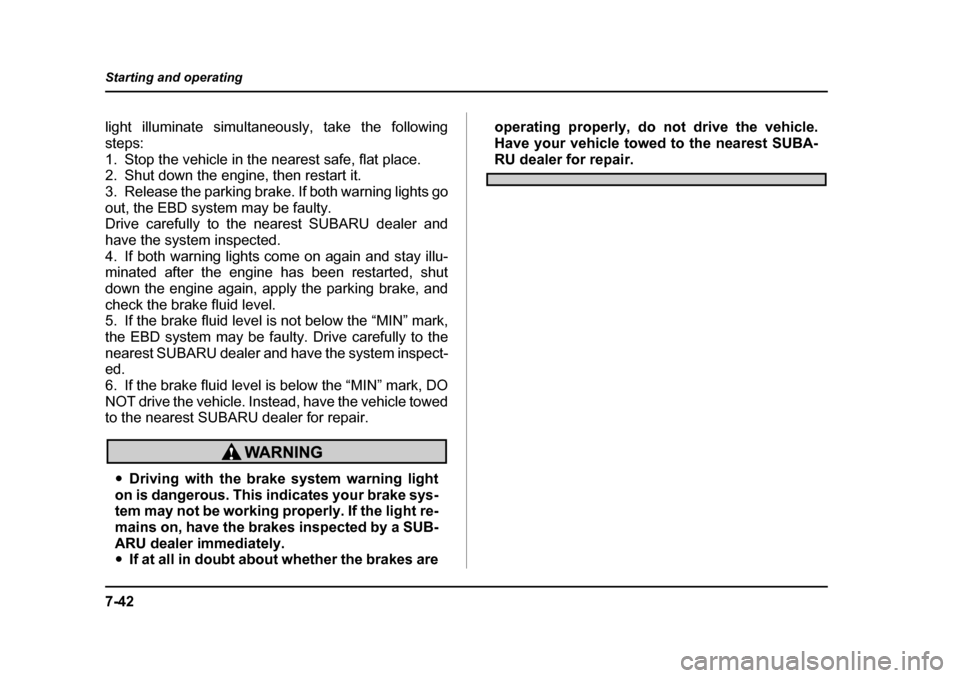
7-42
Starting and operating
light illuminate simultaneously, take the following steps:
1. Stop the vehicle in the nearest safe, flat place.
2. Shut down the engine, then restart it.
3. Release the parking brake. If both warning lights go
out, the EBD system may be faulty.
Drive carefully to the nearest SUBARU dealer and
have the system inspected.
4. If both warning lights come on again and stay illu-
minated after the engine has been restarted, shut
down the engine again, apply the parking brake, and
check the brake fluid level.
5. If the brake fluid level is not below the “MIN” mark,
the EBD system may be faulty. Drive carefully to the
nearest SUBARU dealer and have the system inspect-
ed.
6. If the brake fluid level is below the “MIN” mark, DO
NOT drive the vehicle. Instead, have the vehicle towed
to the nearest SUBARU dealer for repair.
"
Driving with the brake system warning light
on is dangerous. This indicates your brake sys-
tem may not be working properly. If the light re-
mains on, have the brakes inspected by a SUB-
ARU dealer immediately. " If at all in doubt about whether the brakes are operating properly, do not drive the vehicle.
Have your vehicle towed to the nearest SUBA-
RU dealer for repair.
Page 398 of 627
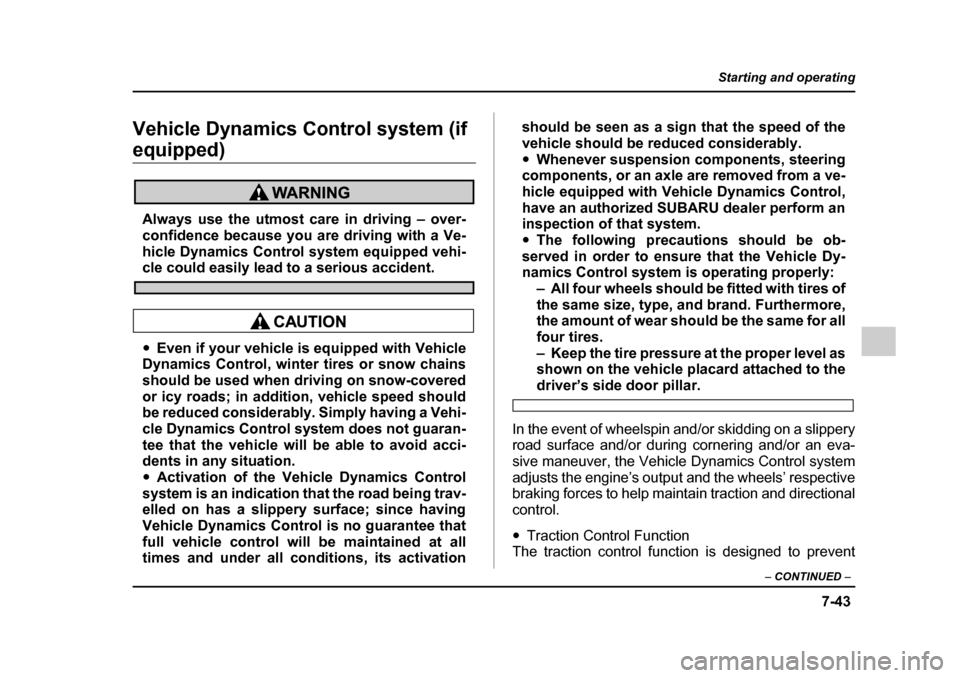
7-43
Starting and operating
– CONTINUED –
Vehicle Dynamics Control system (if
equipped)
Always use the utmost care in driving – over-
confidence because you are driving with a Ve-
hicle Dynamics Control system equipped vehi-
cle could easily lead to a serious accident.
"Even if your vehicle is equipped with Vehicle
Dynamics Control, winter tires or snow chains
should be used when driving on snow-covered
or icy roads; in addition, vehicle speed should
be reduced considerably. Simply having a Vehi-
cle Dynamics Control system does not guaran-
tee that the vehicle will be able to avoid acci-
dents in any situation." Activation of the Vehicle Dynamics Control
system is an indication that the road being trav-
elled on has a slippery surface; since having
Vehicle Dynamics Control is no guarantee that
full vehicle control will be maintained at all
times and under all conditions, its activation should be seen as a sign that the speed of the
vehicle should be reduced considerably."
Whenever suspension components, steering
components, or an axle are removed from a ve-
hicle equipped with Vehicle Dynamics Control,
have an authorized SUBARU dealer perform an
inspection of that system. " The following precautions should be ob-
served in order to ensure that the Vehicle Dy-
namics Control system is operating properly: – All four wheels should be fitted with tires of
the same size, type, and brand. Furthermore,
the amount of wear should be the same for all four tires.
– Keep the tire pressure at the proper level as
shown on the vehicle placard attached to the
driver’s side door pillar.
In the event of wheelspin and/or skidding on a slippery
road surface and/or during cornering and/or an eva-
sive maneuver, the Vehicle Dynamics Control system
adjusts the engine’s output and the wheels’ respective
braking forces to help maintain traction and directional control. " Traction Control Function
The traction control function is designed to prevent
Page 399 of 627

7-44
Starting and operating
spinning of the driving wheels on slippery road surfac-
es, thereby helping to maintain traction and directional
control. Activation of this function is shown by steady
illumination of the Vehicle Dynamics Control operation
indicator light. "
Skid Suppression Function
The skid suppression function is designed to help
maintain directional stability by suppressing the
wheels’ tendency to slide sideways during steering op-
erations. Activation of this function is shown by flash-
ing of the Vehicle Dynamics Control operation indica-
tor light.
NOTE " Slight twitching of the brake pedal may be felt
when the Vehicle Dynamics Control system oper-
ates; a small degree of vehicle or steering wheel
shaking may also be noticed in this situation.
These are normal characteristics of Vehicle Dy-
namics Control operation and are no cause for
alarm. " When driving off immediately after starting the
engine, a short-lived operation noise may be no-
ticed coming from the engine compartment. This
noise is generated as a result of a check being per-
formed on the Vehicle Dynamics Control system
and is normal. "
Depending on the timing of activation of the
brakes, certain situations may occur just after
driving off where the brake pedal seems to exhibit
a jolting motion. This too is a consequence of the
Vehicle Dynamics Control operational check and
is normal. " In the circumstances listed below, the vehicle
may be more unstable than it feels to the driver.
The Vehicle Dynamics Control System may there-
fore operate. Such operation does not indicate a
system fault. "on gravel-covered or rutted roads
" on unfinished roads
" when the vehicle is towing a trailer
" when the vehicle is fitted with snow tires or
winter tires
" Activation of the Vehicle Dynamics Control sys-
tem will cause operation of the steering wheel to
feel slightly different compared to that for normal
conditions." Even if the vehicle is equipped with a Vehicle
Dynamics Control system, it is important that win-
ter tires be used when driving on snow-covered or
icy roads. (All four wheels should be fitted with
tires of the same size and brand). Furthermore, if
snow chains are to be used, they should be fitted
on the front wheels. When a vehicle is fitted with
Page 400 of 627
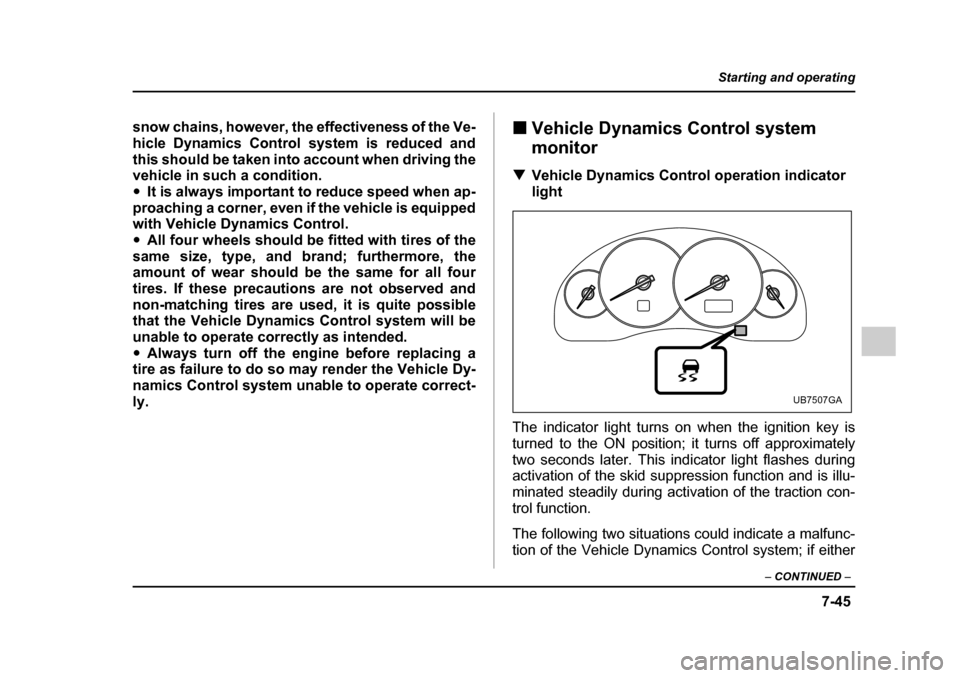
7-45
Starting and operating
– CONTINUED –
snow chains, however, the effectiveness of the Ve-
hicle Dynamics Control system is reduced and
this should be taken into account when driving the
vehicle in such a condition. "It is always important to reduce speed when ap-
proaching a corner, even if the vehicle is equipped
with Vehicle Dynamics Control. " All four wheels should be fitted with tires of the
same size, type, and brand; furthermore, the
amount of wear should be the same for all four
tires. If these precautions are not observed and
non-matching tires are used, it is quite possible
that the Vehicle Dynamics Control system will be
unable to operate correctly as intended." Always turn off the engine before replacing a
tire as failure to do so may render the Vehicle Dy-
namics Control system unable to operate correct-ly. !
Vehicle Dynamics Control system
monitor
! Vehicle Dynamics Control operation indicator
light
The indicator light turns on when the ignition key is
turned to the ON position; it turns off approximately
two seconds later. This indicator light flashes during
activation of the skid suppression function and is illu-
minated steadily during activation of the traction con-
trol function.
The following two situations could indicate a malfunc-
tion of the Vehicle Dynamics Control system; if either
UB7507GA